Zein-Based Films Containing Monolaurin/Eugenol or Essential Oils with Potential for Bioactive Packaging Application
Abstract
:1. Introduction
2. Results
2.1. Mechanical Properties
2.2. Thickness of the Films
2.3. Water Vapor Permeability
2.4. Surface Properties
2.5. FTIR Analysis
2.6. Differential Scanning Calorimetry (DSC)
2.7. SEM Analysis
2.8. AFM Analysis
2.9. Antimicrobial Properties
3. Discussion
4. Materials and Methods
4.1. Materials, Chemicals and Microorganisms
4.2. Preparation of Zein Films
4.3. Mechanical Properties
4.4. Thickness
4.5. Water Vapor Permeability
4.6. Surface Properties
4.7. Fourier-Transform Infrared Spectroscopy (FTIR)
4.8. Differential Scanning Calorimetry (DSC)
4.9. SEM Analysis
4.10. Atomic force microscopy
4.11. Antimicrobial Properties
4.12. Statistical Analysis
5. Conclusions
Supplementary Materials
Author Contributions
Funding
Institutional Review Board Statement
Informed Consent Statement
Data Availability Statement
Acknowledgments
Conflicts of Interest
References
- Khalil, A.A.; Deraz, S.F. Enhancement of mechanical properties, microstructure, and antimicrobial activities of zein films cross-linked using succinic anhydride, eugenol, and citric acid. Prep. Biochem. Biotechnol. 2015, 45, 551–567. [Google Scholar] [CrossRef] [PubMed]
- Escamilla-Garcia, M.; Calderon-Dominguez, G.; Chanona-Perez, J.J.; Mendoza-Madrigal, A.G.; Di Pierro, P.; García-Almendárez, B.E.; Amaro-Reyes, A.; Regalado-González, C. Physical, structural, barrier and antifungal characterization of chitosan-zein edible films with added essential oils. Int. J. Mol. Sci. 2017, 18, 2370. [Google Scholar] [CrossRef] [PubMed] [Green Version]
- Talon, E.; Vargas, M.; Chiralt, A.; Gonzalez-Matinez, C. Antioxidant starch-based films with encapsulated eugenol. Application to sunflower oil preservation. LWT—Food Sci. Technol. 2019, 113, 108290. [Google Scholar] [CrossRef]
- Norn, V. Emulsifiers in Food Technology, 2nd ed.; Wiley Blackwell Publishing: Ames, IA, USA, 2015. [Google Scholar]
- Sevcikova, P.; Kasparkova, V.; Hauerlandova, I.; Humpolicek, P.; Kucekova, Z.; Bunkova, L. Formulation, antibacterial activity, and cytotoxicity of 1-monoacylglycerol microemulsions. Eur. J. Lipid Sci. Technol. 2014, 116, 448–457. [Google Scholar]
- Jackman, J.; Yoon, B.K.; Li, D.; Cho, N. Nanotechnology formulations for antibacterial free fatty acids and monoglycerides. Molecules 2016, 21, 305. [Google Scholar] [CrossRef] [Green Version]
- Luís, A.; Domingues, F.; Ramos, A. Production of hydrophobic zein-based films bioinspired by the lotus leaf surface: Characterization and bioactive properties. Microorganisms 2019, 7, 267. [Google Scholar] [CrossRef] [Green Version]
- Sedlarikova, J.; Janalikova, M.; Rudolf, O.; Pavlačková, J.; Egner, P.; Peer, P.; Varaďová, V.; Krejčí, J. Chitosan/Thyme Oil Systems as Affected by Stabilizing Agent: Physical and Antimicrobial Properties. Coatings 2019, 9, 165. [Google Scholar] [CrossRef] [Green Version]
- Altiok, D.; Altiok, E.; Tihminlioglu, F. Physical, antibacterial and antioxidant properties of chitosan films incorporated with thyme oil for potential wound healing applications. J. Mater. Sci. Mater. Med. 2010, 21, 2227–2236. [Google Scholar] [CrossRef] [Green Version]
- Vahedikia, N.; Garavand, F.; Tajeddin, B.; Cacciotti, I.; Jafari, S.M.; Omidi, T.; Zahedi, Z. Biodegradable zein film composites reinforced with chitosan nanoparticles and cinnamon essential oil: Physical, mechanical, structural and antimicrobial attributes. Colloids Surf. B Biointerfaces 2019, 177, 25–32. [Google Scholar] [CrossRef]
- Boyaci, D.; Iorio, G.; Sozbilen, G.S.; Alkan, D.; Trabattoni, S.; Pucillo, F.; Farrisb, S.; Yemenicioğlua, A. Development of flexible antimicrobial zein coatings with essential oils for the inhibition of critical pathogens on the surface of whole fruits: Test of coatings on inoculated melons. Food Packag. Shelf Life 2019, 20, 100316. [Google Scholar] [CrossRef]
- Ribeiro, W.X.; Filho, J.F.L.; Cortes, M.S. Characterization of biodegradable film based on zein and oleic acid added with nanocarbonate. Food Technol. 2015, 45, 1890–1894. [Google Scholar] [CrossRef] [Green Version]
- Pereira, L.A.S.; Silva, P.; Pagnossa, J.P.; Miranda, K.W.E.; Medeiros, E.S.; Piccoli, R.H.; Oliveira, J.E.D. Antimicrobial zein coatings plasticized with garlic and thyme essential oils. Brazilian J. Food Technol. 2019, 22. [Google Scholar] [CrossRef]
- Aitboulahsen, M.; El Galiou, O.; Bakkali, M.; Zerrouk, M.H. Effect of plasticizer type and essential oils on mechanical, physicochemical, and antimicrobial characteristics of gelatin, starch, and pectin-based films. J. Food Process. Preserv. 2020, 44, e14480. [Google Scholar] [CrossRef]
- Nining, N.; Elfiyani, R.; Wulandari, E. Comparison eugenol and oleic acid as a plasticizer on characteristic of dextromethorphan hydrobromide film by solvent casting method. Pharm. Sci. Asia 2021, 48, 139–146. [Google Scholar] [CrossRef]
- Vieira, M.G.A.; da Silva, M.A.; Beppu, M.M. Natural-based plasticizers and biopolymer films: A review. Eur. Polym. 2011, 47, 254–263. [Google Scholar] [CrossRef] [Green Version]
- Biswas, A.; Bastos, M.S.R.; Kuzniar, G.; Boddu, V.; Cheng, H.N. Evaluation of properties of cellulose ester films that incorporate essential oils. Int. J. Polym. Sci. 2020, 2020. [Google Scholar] [CrossRef]
- Sedlarikova, J.; Dolezalova, M.; Egner, P.; Pavlackova, J.; Krejci, J.; Rudolf, O.; Peer, P. Effect of oregano and marjoram essential oils on the physical and antimicrobial properties of chitosan based systems. Int. J. Polym. Sci. 2017, 2017, 2593863. [Google Scholar] [CrossRef]
- Ghasemloua, M.; Aliheidari, N.; Fahmi, R.; Shojaee-Aliabadi, S.; Keshavarz, B.; Cran, M.J.; Khaksar, R. Physical, mechanical and barrier properties of corn starch films incorporated with plant essential oils. Carbohydr. Polym. 2013, 98, 1117–1126. [Google Scholar] [CrossRef] [Green Version]
- Moradi, M.; Tajik, H.; Rohani, S.M.R.; Oromiehie, A.R.; Malekinejad, H.; Aliakbarlu, J.; Hadian, M. Characterization of antioxidant chitosan film incorporated with Zataria multiflora Boiss essential oil and grape seed extract. LWT—Food Sci. Technol. 2012, 46, 477–484. [Google Scholar] [CrossRef]
- Pintado, C.M.B.S.; Ferreira, M.A.S.S.; Sousa, I. Control of pathogenic and spoilage microorganisms from cheese surface by whey protein films containing malic acid, nisin and natamycin. Food Control 2010, 21, 240–246. [Google Scholar] [CrossRef] [Green Version]
- Ghasemi, S.; Javadi, N.H.S.; Moradi, M.; Khosravi-Darani, K. Application of zein antimicrobial edible film incorporating Zataria multiflora boiss essential oil for preservation of Iranian ultrafiltered Feta cheese. Afr. J. Biotechnol. 2015, 14, 2014–2021. [Google Scholar]
- Shi, K.; Kokini, J.L.; Huang, Q. Engineering Zein Films with Controlled Surface Morphology and Hydrophilicity. J. Agric. Food Chem. 2009, 57, 2186–2192. [Google Scholar] [CrossRef]
- Gu, L.; Wang, M.; Zhou, J. Effects of protein interactions on properties and microstructure of zein–gliadin composite films. J. Food Eng. 2013, 119, 288–298. [Google Scholar] [CrossRef]
- Wu, L.; Wen, Q.; Yang, X.; Xu, M.S.; Yin, S.W. Wettability, surface microstructure and mechanical properties of films based on phosphorus oxychloride-treated zein. J. Sci. Food Agric. 2011, 941, 1222–1229. [Google Scholar] [CrossRef]
- Peer, P.; Sedlariková, J.; Janalikova, M.; Kucerova, L.; Pleva, P. Novel Polyvinyl Butyral/Monoacylglycerol Nanofibrous Membrane with Antifouling Activity. Materials 2020, 13, 3662. [Google Scholar] [CrossRef]
- Lopez-Garcia, J.; Cupessala, F.; Humpolicek, P.; Lehocky, M. Physical and Morphological Changes of Poly(tetrafluoroethylene) after Using Non-Thermal Plasma-Treatments. Materials 2018, 11, 2013. [Google Scholar] [CrossRef] [Green Version]
- Malm, M.J.; Narsimhan, G.; Kokini, J.L. Effect of contact surface, plasticized and crosslinked zein films are cast on, on the distribution of dispersive and polar surface energy using the Van Oss method of deconvolution. J. Food Eng. 2019, 263, 262–271. [Google Scholar] [CrossRef]
- Ali, S.; Khatri, Z.; Oh, K.W.; Kim, I.S.; Kim, S.H. Zein/cellulose acetate hybrid nanofibers: Electrospinning and characterization. Macromol. Res. 2014, 22, 971–977. [Google Scholar] [CrossRef]
- Peer, P.; Janalikova, M.; Sedlarikova, J.; Pleva, P.; Filip, P.; Zelenkova, J.; Opalkova Sisikova, A. Antibacterial filtration membranes based on PVDF-co-HFP nanofibers with the addition of medium-chain 1-monoacylglycerols. ACS Appl. Mater. Interfaces 2021, 13, 41021–41033. [Google Scholar] [CrossRef] [PubMed]
- Chinatangul, N.; Limmatvapirat, C.; Nunthanid, J.; Luangtana-Anan, M.; Sriamornsak, P.; Limmatvapirat, S. Design and characterization of monolaurin loaded electrospun shellas nanofibers with antimicrobial activity. Asian J. Pharm. Sci. 2018, 13, 459–471. [Google Scholar] [CrossRef] [PubMed]
- Kaewmanee, P.C.; Wongsatayanon, B.; Durand, A. Encapsulation of bioactive compounds (mono-caprin and monolaurin) into polymeric nanoparticles. Mater. Sci. Forum. 2018, 916, 147–152. [Google Scholar] [CrossRef]
- Bueno, J.N.N.; Corradini, E.; Souza, P.R.; Marques, V.D.S.; Radovanovic, E.; Muniz, E.C. Films based on mixtures of zein, chitosan, and PVA: Development with perspectives for food packaging application. Polym. Test. 2021, 101, 107279. [Google Scholar] [CrossRef]
- Carmagnola, I.; Nardo, T.; Gentile, P.; Tomda-Turo, C.; Mattu, C.; Cabodi, S.; Defilippi, P.; Chiono, V. Poly(Lactic Acid)-Based Blends with Tailored Physicochemical Properties for Tissue Engineering Applications: A Case Study. Int. J. Polym. Mater. Polym. Biomater. 2015, 64, 90–98. [Google Scholar] [CrossRef]
- Wrzecionko, E.; Minarik, A.; Smolka, P.; Minařík, M.; Humpolíček, P.; Rejmontová, P.; Mráček, A.; Minaříková, M.; Gřundělová, L. Variations of Polymer Porous Surface Structures via the Time-Sequenced Dosing of Mixed Solvents. ACS Appl. Mater. Interfaces 2017, 9, 6472–6481. [Google Scholar] [CrossRef] [Green Version]
- Minarik, M.; Wrzecionko, E.; Minarik, A.; Grulich, O.; Smolka, P.; Musilová, L.; Junkar, I.; Primc, G.; Ptošková, B.; Mozetič, M.; et al. Preparation of Hierarchically Structured Polystyrene Surfaces with Superhydrophobic Properties by Plasma-Assisted Fluorination. Coatings 2019, 9, 201. [Google Scholar] [CrossRef] [Green Version]
- Wenzel, R.N. Resistance of solid surfaces to wetting by water. Ind. Eng. Chem. 1936, 28, 988–994. [Google Scholar] [CrossRef]
- Cassie, A.B.D.; Baxter, S. Wettability of porous surfaces. Trans. Faraday Soc. 1944, 40, 546–551. [Google Scholar] [CrossRef]
- Milne, A.J.B.; Amirfazli, A. The Cassie equation: How it is mean to be used. Adv. Colloid Interface Sci. 2012, 170, 48–55. [Google Scholar] [CrossRef]
- Bormashenko, E. Progress in understanding wetting transitions on rough surfaces. Adv. Colloid Interface Sci. 2015, 222, 92–103. [Google Scholar] [CrossRef] [PubMed]
- Kashiri, M.; Cerisuelo, J.P.; Dominguez, I.; López-Carballo, G.; Hernández-Muñoz, P.; Gavara, R. Novel antimicrobial zein film for controlled release of lauroyl arginate (LAE). Food Hydrocoll. 2016, 61, 547–554. [Google Scholar] [CrossRef] [Green Version]
- Luo, C.; Zeng, Z.; Gong, D.; Zhao, C.; Liang, Q.; Zeng, C. Evaluation of monolaurin from camphor tree seeds for controlling food spoilage fungi. Food Control 2014, 46, 488–494. [Google Scholar] [CrossRef]
- Mansour, N.; Yousef, A.E.; Kim, J. Inhibition of surface growth of toxigenic and nontoxigenic Aspergilli and Penicillia by eugenol, isoeugenol and monolaurin. J. Food Saf. 1996. [Google Scholar] [CrossRef]
- Krishnamurthi, V.R.; Niyonshuti, I.I.; Chen, J.; Wang, Y.; Barnwal, R.P. A new analysis method for evaluating bacterial growth with microplate readers. PLoS ONE 2021, 16, 1–19. [Google Scholar] [CrossRef] [PubMed]
- Perni, S.; Andrew, P.W.; Shama, G. Estimating the maximum growth rate from microbial growth curves: Definition is everything. Food Microbiol. 2005, 22, 491–495. [Google Scholar] [CrossRef] [Green Version]
- Sakkas, H.; Papadopoulou, C. Antimicrobial Activity of Basil, Oregano, and Thyme Essential Oils. J. Microbiol. Biotechnol. 2017, 27, 429–438. [Google Scholar] [CrossRef] [Green Version]
- Xu, H.; Chai, Y.; Zhang, G. Synergistic effect of oleic acid and glycerol on zein film plasticization. J. Agric. Food. Chem. 2012, 60, 10075–10081. [Google Scholar] [CrossRef]
- Qu, L.; Chen, G.; Dong, S.; Huo, Y.; Yin, Z.; Li, S.; Chen, Y. Improved mechanical and antimicrobial properties of zein/chitosan films by adding highly dispersed nano-TiO2. Ind. Crops Prod. 2019, 130, 450–458. [Google Scholar] [CrossRef]
- Zhou, L.; Wang, Y. Physical and antimicrobial properties of zein and methyl cellulose composite films with plasticizers of oleic acid and polyethylene glycol. LWT 2021, 140, 110811. [Google Scholar] [CrossRef]
- Xuan, W.; Odelius, K.; Hakkarainen, M. Dual-functioning antibacterial eugenol-derived plasticizers for polylactide. Biomolecules 2020, 10, 1077. [Google Scholar] [CrossRef]
- Ghanbarzadeh, B.; Oromiehie, A.; Rezaei, K.E.; Razmi, E.; Milani, J.; Ouroumiehei, A.A. Investigation of water vapour permeability, hydrophobicity and morphology of zein films plasticized by polyols. Iran. Polym. J. 2006, 15, 691–700. [Google Scholar]
- Ordon, M.; Zdanowicz, M.; Nawrotek, P. Stachurska, X.; Mizielinska, M. Polyethylene films containing plant extracts in the polymer matrix as antibacterial and antiviral materials. Int. J. Mol. Sci. 2021, 22, 13438. [Google Scholar] [CrossRef]
- Blaszyk, M.; Holley, R.A. Interaction of monolaurin, eugenol and sodium citrate on growth of common meat spoilage and pathogenic organisms. Int. J. Food Microbiol. 1998, 39, 175–183. [Google Scholar] [CrossRef]
- Moradi, M.; Tajik, H.; Rohani, S.M.R.; Mahmoudian, A. Antioxidant and antimicrobial effects of zein edible film impregnated with Zataria multiflora Boiss. essential oil and monolaurin. LWT-Food Sci. Technol. 2016, 72, 37–43. [Google Scholar] [CrossRef]
- ASTM E96–95; Standard Test Methods for Water Vapor Transmission of Materials. ASTM International: West Conshohocken, PA, USA, 1995.
- Cech, V.; Lichovnikova, S.; Sova, J.; Studynka, J. Surface-Free Energy of Silicon Based Plasma Polymer Films. In Silanes and Other Coupling Agents; CRC PRESS: Boca Raton, FL, USA, 2009; Volume 5, pp. 333–348. [Google Scholar] [CrossRef]
- Ferrer, C.; Ramón, D.; Muguerza, B.; Marco, A.; Martinez, A. Effect of olive powder on the growth and inhibition of Bacillus cereus. Foodborne Pathog. Dis. 2009, 6. [Google Scholar] [CrossRef] [PubMed]
- Zabihi, E.; Babaei, A.; Arab-Bafrani, Z.; Mirshahidi, K.S.; Majidi, H.J. Facile and rapid in-situ synthesis of chitosan-ZnO nano-hybrids applicable in medical purposes; a novel combination of biomineralization, ultrasound, and bio-safe morphology-conducting agent. Int. J. Biol. Macromol. 2019, 131, 107–116. [Google Scholar] [CrossRef] [PubMed]
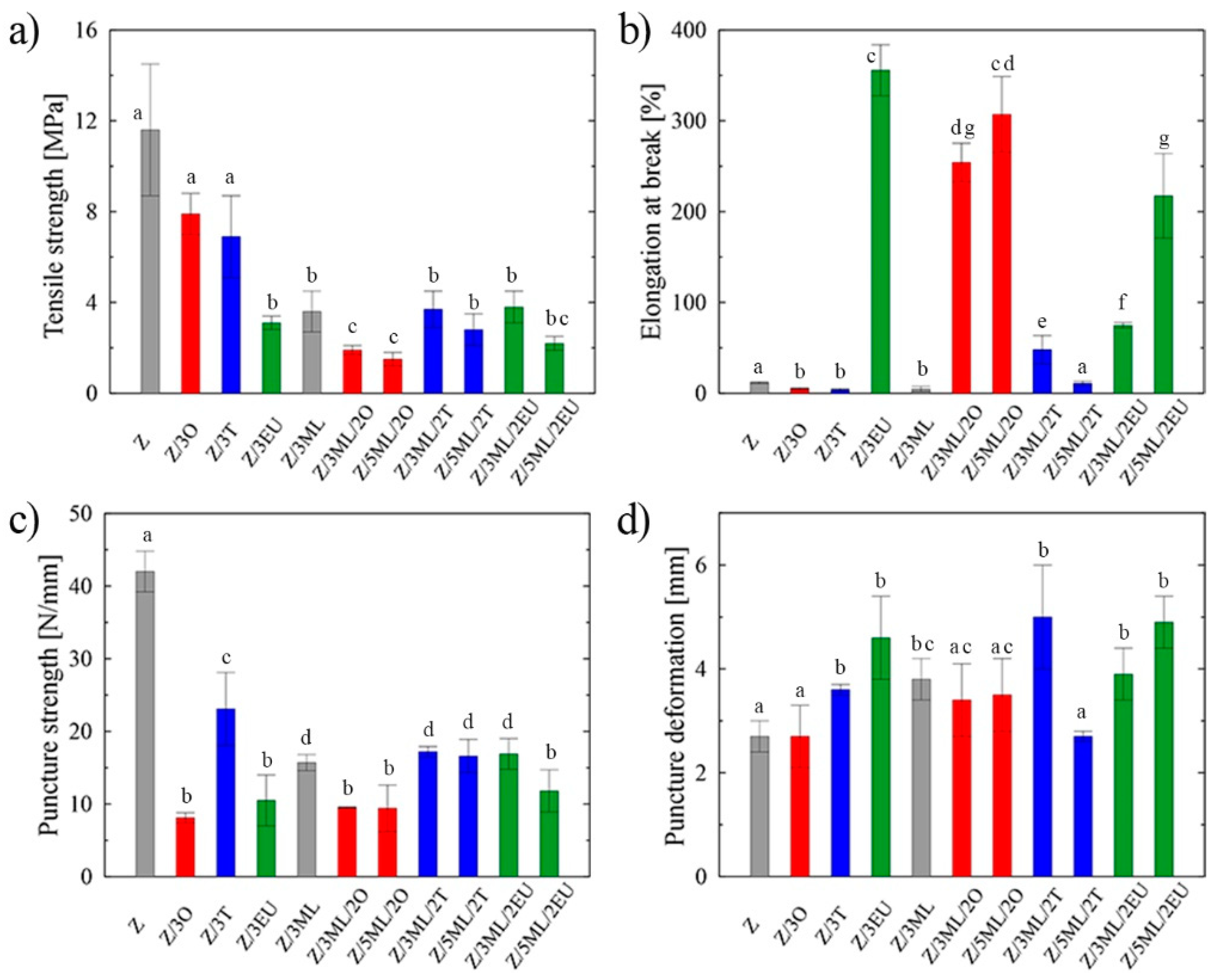
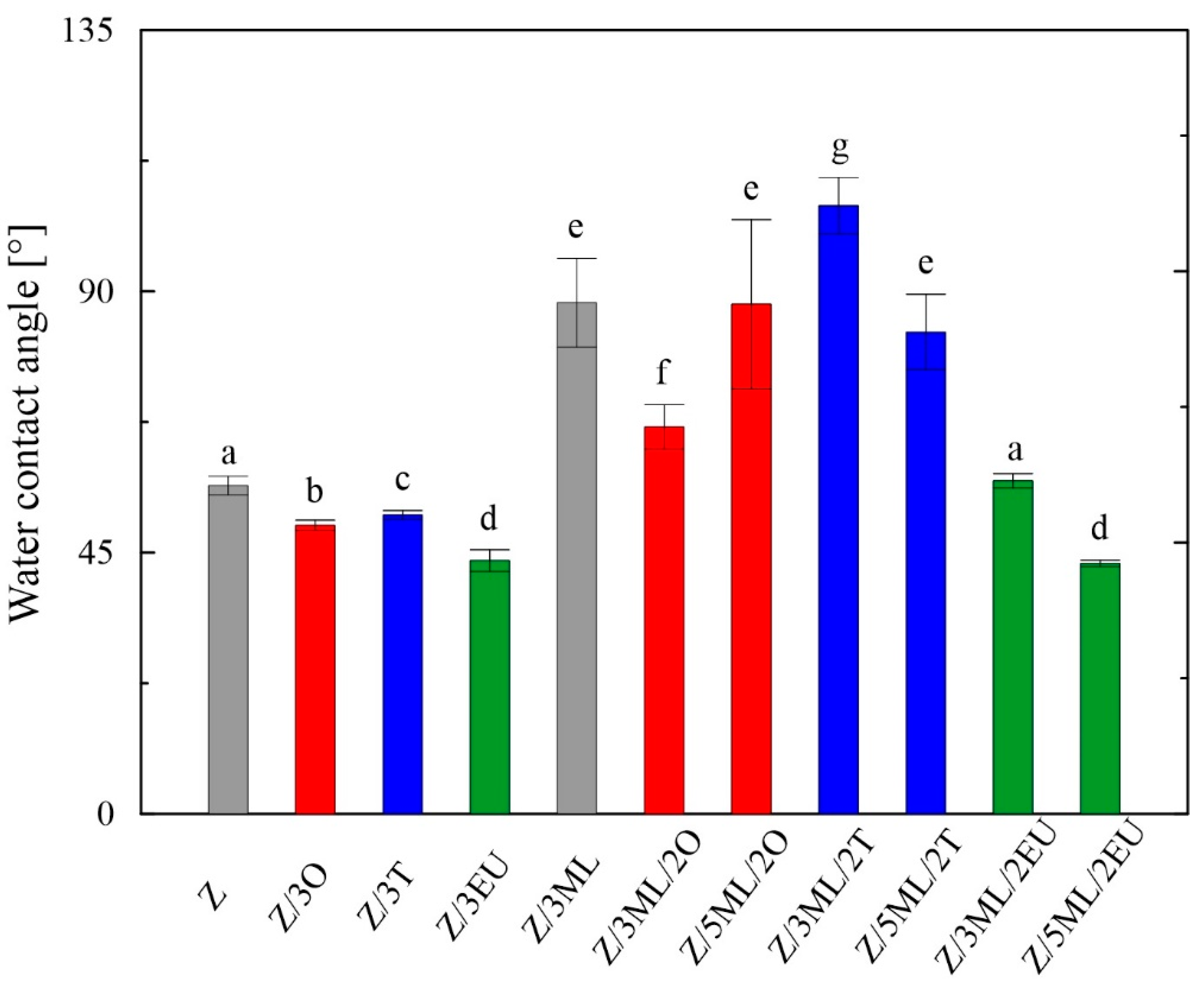
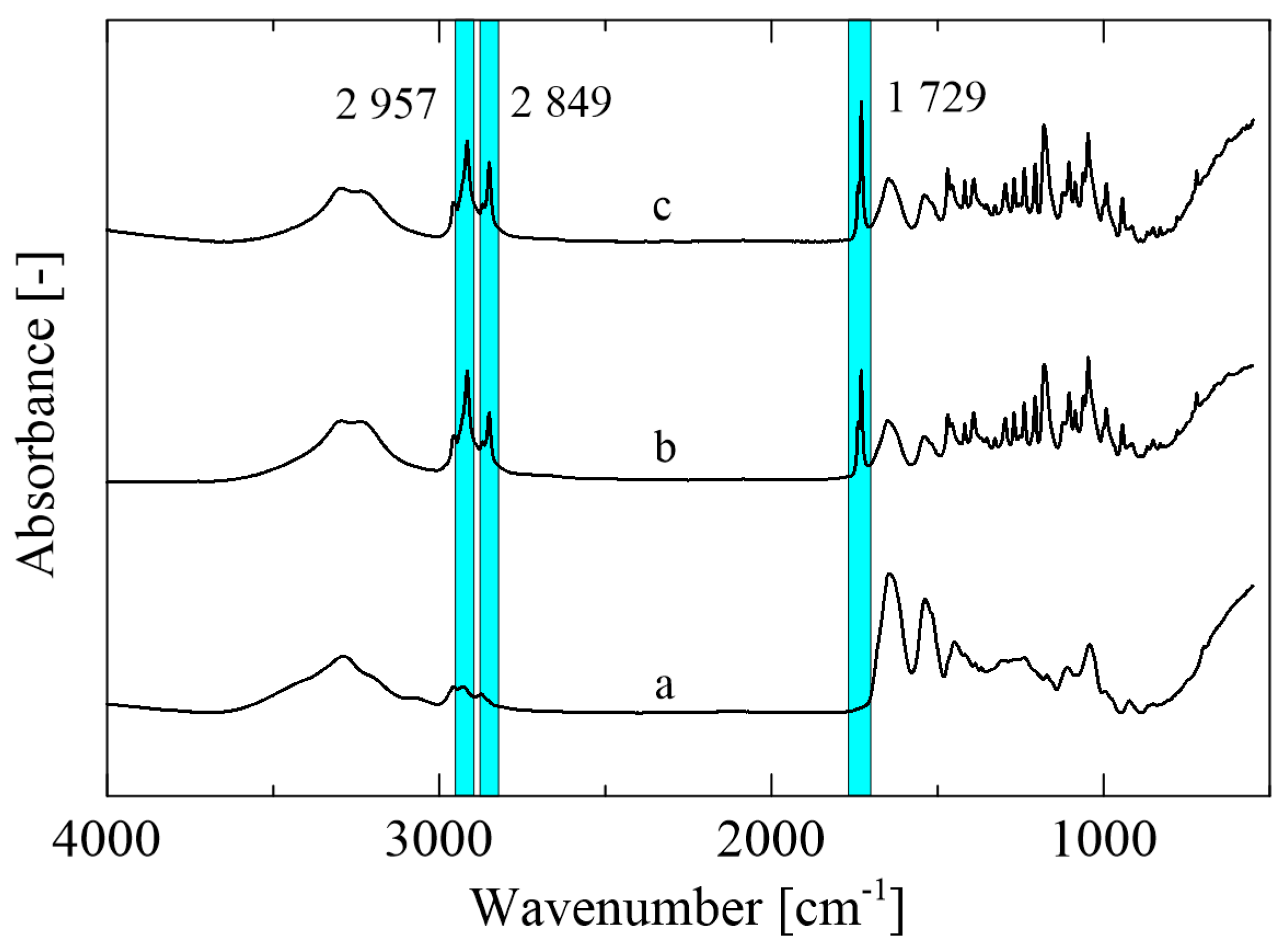
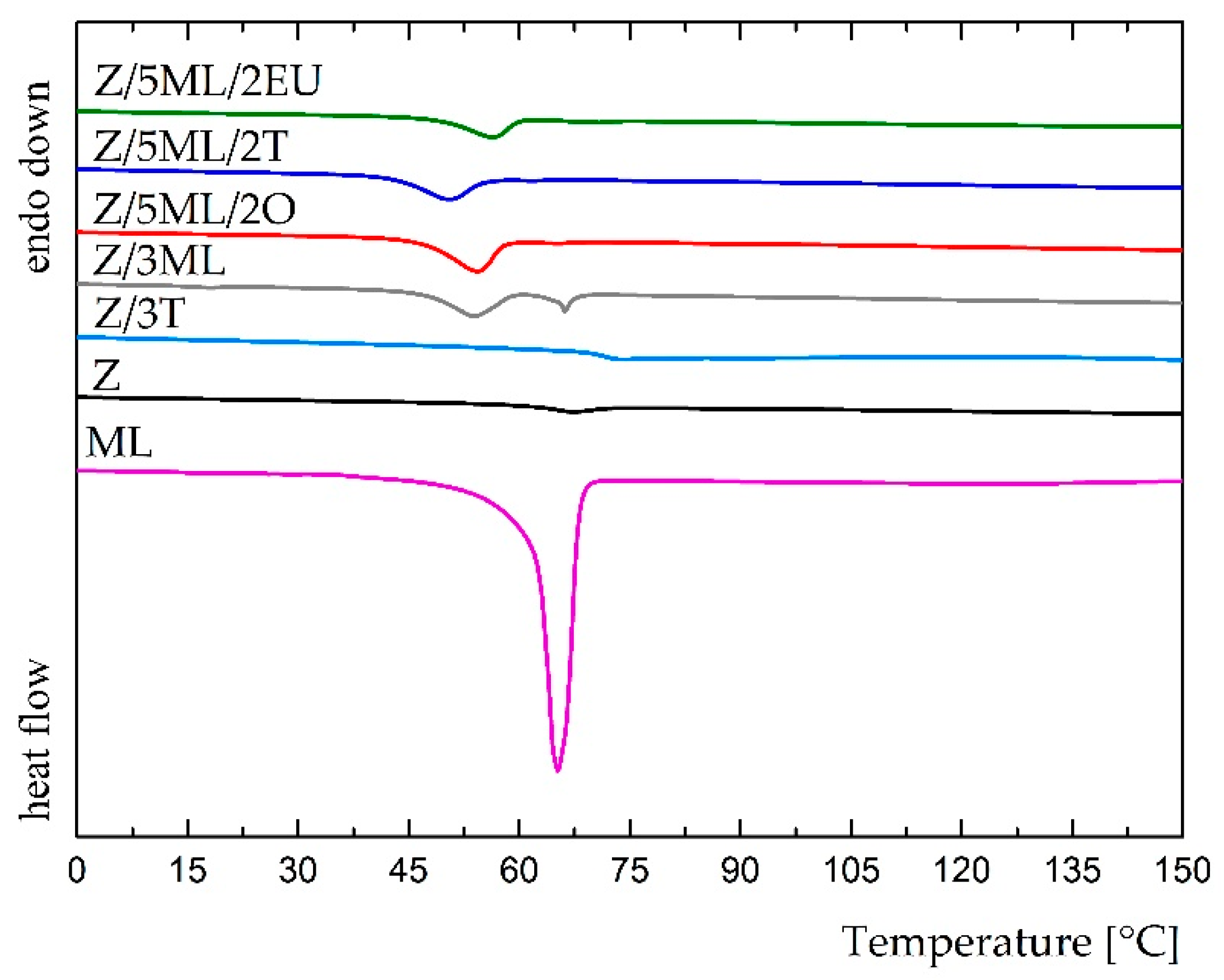


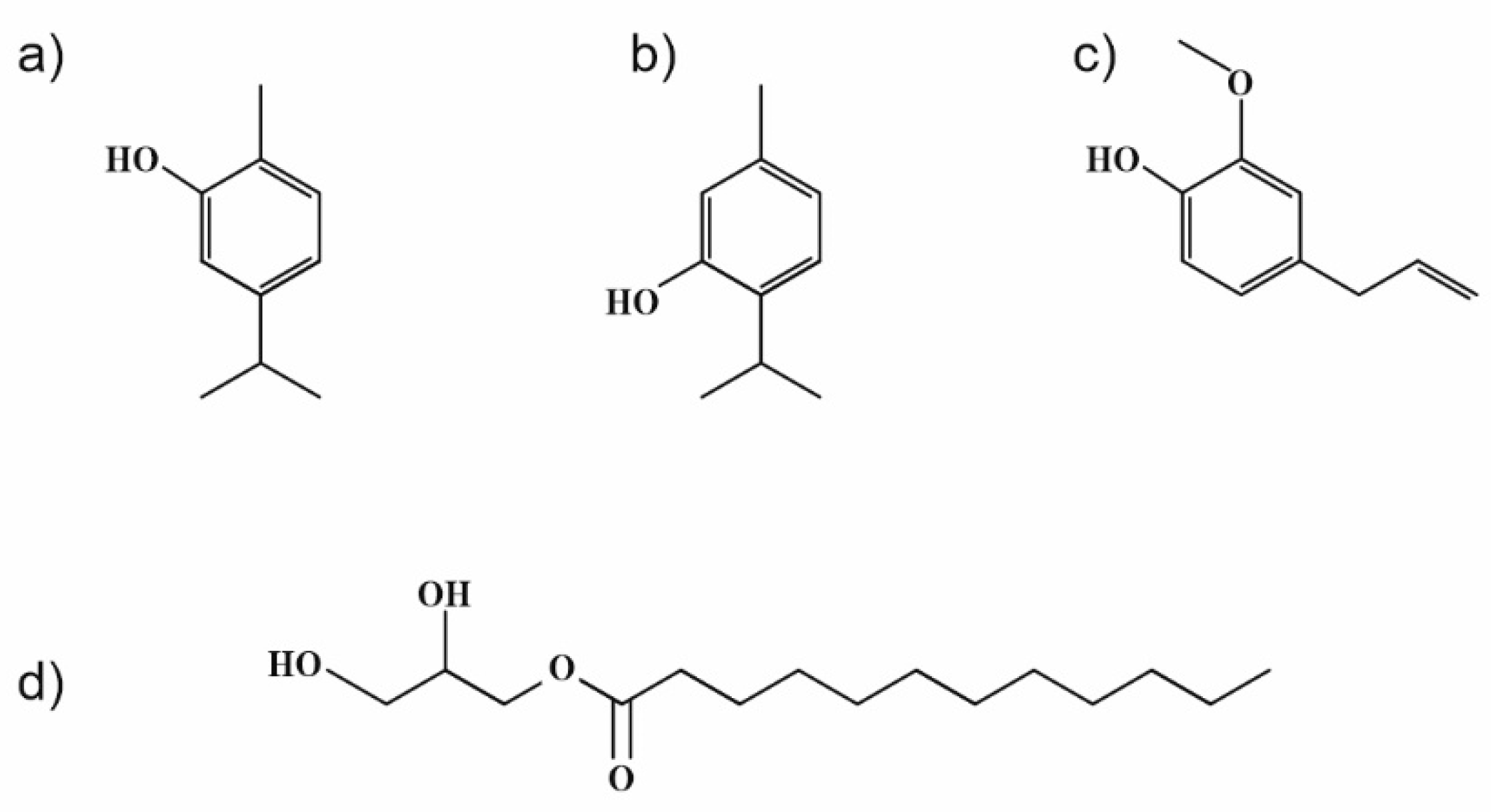

| Sample | Monolaurin (wt%) | Thyme (wt%) | Oregano (wt%) | Eugenol (wt%) |
|---|---|---|---|---|
| Z | - | - | - | - |
| Z/3T | - | 3 | - | - |
| Z/3O | - | - | 3 | - |
| Z/3EU | - | - | - | 3 |
| Z/3ML | 3 | - | - | - |
| Z/3ML/2O | 3 | - | 2 | - |
| Z/5ML/2O | 5 | - | 2 | - |
| Z/3ML/2T | 3 | 2 | - | - |
| Z/5ML/2T | 5 | 2 | - | - |
| Z/3ML/2EU | 3 | - | - | 2 |
| Z/5ML/2EU | 5 | - | - | 2 |
| Sample | Thickness (µm) | WVP (g/Pa.h.m2) |
|---|---|---|
| Z | 258 ± 4 | 6.14 ± 0.1 |
| Z/3O | 266 ± 7 | 1.23 ± 0.2 |
| Z/3T | 278 ± 16 | 1.37 ±0.01 |
| Z/3EU | 285 ± 2 | 1.46 ± 0.02 |
| Z/3ML | 174 ± 6 | 3.59 ± 0.07 |
| Z/5ML/2O | 262 ± 17 | 1.44 ± 0.2 |
| Z/5ML/2T | 175 ± 6 | 1.75 ± 0.03 |
| Z/5ML/2EU | 202 ± 14 | 1.82 ± 0.15 |
| Sample | γtot [mJ/m2] | γd [mJ/m2] | γp [mJ/m2] |
|---|---|---|---|
| Z | 44.8 ± 1.9 | 9.0 ± 2.0 | 35.9 ± 3.8 |
| Z/3O | 57.6 ± 1. | 2.1 ± 0.3 | 55.5 ± 1.7 |
| Z/3T | 51.9 ± 1.7 | 4.8 ± 1.1 | 47.1 ± 2.7 |
| Z/3EU | 60.5 ± 2.9 | 3.8 ± 0.8 | 56.6 ± 3.7 |
| Z/3ML | 17.3 ± 1.7 | 2.8 ± 0.5 | 14.5 ± 2.2 |
| Z/3ML/2O | 38.9 ± 2.9 | 4.1 ± 0.3 | 34.7 ± 8.3 |
| Z/5ML/2O | 18.5 ± 5.3 | 15.5 ± 2.5 | 3.0 ± 0.9 |
| Z/3ML/2T | 18.8 ± 3.9 | 16.8 ± 3.6 | 2.0 ± 0.2 |
| Z/5ML/2T | 29.3 ± 2.1 | 1.3 ± 0.2 | 28.0 ± 1.9 |
| Z/3ML/2EU | 83.0 ± 8.0 | 3.1 ± 1.4 | 79.9 ± 6.6 |
| Z/5ML/2EU | 74.0 ± 2.3 | 0.2 ± 0.2 | 73.8 ± 2.5 |
| Sample | γtot [mJ/m2] | γd [mJ/m2] | γp [mJ/m2] |
|---|---|---|---|
| Z | 46.3 ± 1.2 | 12.9 ± 0.9 | 33.4 ± 2.1 |
| Z/3O | 53.0 ± 0.8 | 9.0 ± 0.2 | 44.0 ± 0.9 |
| Z/3T | 50.5 ± 0.8 | 11.0 ± 0.8 | 39.5 ± 1.4 |
| Z/3EU | 56.3 ± 1.6 | 11.6 ± 0.5 | 44.7 ± 2.0 |
| Z/3ML | 22.7 ± 3.4 | 2.6 ± 2.4 | 20.1 ± 9.8 |
| Z/3ML/2O | 39.8 ± 0.1 | 7.0 ± 5.1 | 32.9 ± 4.9 |
| Z/5ML/2O | 20.7 ± 1.1 | 13.4 ± 1.3 | 7.3 ± 0.2 |
| Z/3ML/2T | 19.9 ± 0.8 | 13.5 ± 1.8 | 6.5 ± 0.1 |
| Z/5ML/2T | 32.7 ± 1.6 | 3.4 ± 0.6 | 29.2 ± 1.0 |
| Z/3ML/2EU | 60.2 ± 3.6 | 0.7 ± 0.0 | 59.5 ± 4.3 |
| Z/5ML/2EU | 60.9 ± 0.9 | 7.0 ± 0.2 | 54.0 ± 1.4 |
| Sample | Inhibition zone (mm) | |
|---|---|---|
| Staphylococcus aureus | Escherichia coli | |
| Z | * | * |
| Z/3T | * | * |
| Z/3O | 15 ± 0.0 | * |
| Z/3ML | 11.5 ± 0.7 | * |
| Z/3EU | 17.3 ± 0.3 | 14.0 ± 1.0 |
| Z/3ML/2O | 15.3 ± 0.2 | * |
| Z/5ML/2O | 21 ± 0.2 | 13.5 ± 0.7 |
| Z/3ML/2T | 18 ± 0.9 | * |
| Z/5ML/2T | 18.4 ± 0.6 | * |
| Z/3ML/2EU | 22.3 ± 0.3 | 10.0 ± 0.0 |
| Z/5ML/2EU | 20.7 ± 0.7 | 12 ± 0.2 |
| Sample | Inhibition zone (mm) | |
|---|---|---|
| Candida albicans | Aspergillus niger | |
| Z | * | * |
| Z/3T | * | * |
| Z/3O | * | * |
| Z/3ML | * | * |
| Z/3EU | 11.3 ± 0.5 | * |
| Z/3ML/2O | * | * |
| Z/5ML/2O | 16.7 ± 0.8 | 13.1 ± 0.0 |
| Z/3ML/2T | * | * |
| Z/5ML/2T | * | * |
| Z/3ML/2EU | 17.2 ± 0.5 | 15.9± 0.8 |
| Z/5ML/2EU | 15.0 ± 0.1 | 11.3 ± 0.3 |
| Bacteria | Sample | λ (h) | A (Log CFU.L−1) | μmax (Log CFU.L−1.h−1) | Adj. R2 |
|---|---|---|---|---|---|
| E. coli | Control | 4.146 ± 0.038 a | 0.483 ± 0.029 a | 0.602 ± 0.018 a | 0.997 |
| Z | 3.792 ± 0.034 a | 0.353 ± 0.036 a | 0.525 ± 0.012 a | 0.998 | |
| Z/3O | -* | - | - | - | |
| Z/5ML/2O | - | - | - | - | |
| Z/3EU | - | - | - | - | |
| Z/5ML/2EU | - | - | - | - | |
| S. aureus | Control | 6.217 ± 0.201 a | 0.402 ± 0.008 a | 0.269 ± 0.022 a | 0.999 |
| Z | 6.759 ± 0.144 a | 0.428 ± 0.016 a | 0.231± 0.012 a | 0.988 | |
| Z/3O | - | - | - | - | |
| Z/5ML/2O | - | - | - | - | |
| Z/3EU | - | - | - | - | |
| Z/5ML/2EU | - | - | - | - | |
Publisher’s Note: MDPI stays neutral with regard to jurisdictional claims in published maps and institutional affiliations. |
© 2021 by the authors. Licensee MDPI, Basel, Switzerland. This article is an open access article distributed under the terms and conditions of the Creative Commons Attribution (CC BY) license (https://creativecommons.org/licenses/by/4.0/).
Share and Cite
Sedlarikova, J.; Janalikova, M.; Peer, P.; Pavlatkova, L.; Minarik, A.; Pleva, P. Zein-Based Films Containing Monolaurin/Eugenol or Essential Oils with Potential for Bioactive Packaging Application. Int. J. Mol. Sci. 2022, 23, 384. https://doi.org/10.3390/ijms23010384
Sedlarikova J, Janalikova M, Peer P, Pavlatkova L, Minarik A, Pleva P. Zein-Based Films Containing Monolaurin/Eugenol or Essential Oils with Potential for Bioactive Packaging Application. International Journal of Molecular Sciences. 2022; 23(1):384. https://doi.org/10.3390/ijms23010384
Chicago/Turabian StyleSedlarikova, Jana, Magda Janalikova, Petra Peer, Lucie Pavlatkova, Antonin Minarik, and Pavel Pleva. 2022. "Zein-Based Films Containing Monolaurin/Eugenol or Essential Oils with Potential for Bioactive Packaging Application" International Journal of Molecular Sciences 23, no. 1: 384. https://doi.org/10.3390/ijms23010384
APA StyleSedlarikova, J., Janalikova, M., Peer, P., Pavlatkova, L., Minarik, A., & Pleva, P. (2022). Zein-Based Films Containing Monolaurin/Eugenol or Essential Oils with Potential for Bioactive Packaging Application. International Journal of Molecular Sciences, 23(1), 384. https://doi.org/10.3390/ijms23010384






